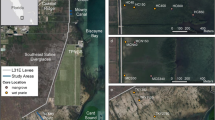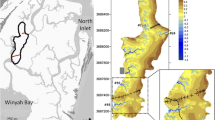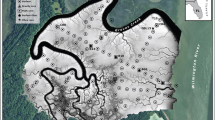Abstract
Although coastal vegetated ecosystems are widely recognised as important sites of long-term carbon (C) storage, substantial spatial variability exists in quantifications of these ‘blue C’ stocks. To better understand the factors behind this variability we investigate the relative importance of geomorphic and vegetation attributes to variability in the belowground C stocks of saltmarshes in New South Wales (NSW), southeast Australia. Based on the analysis of over 140 sediment cores, we report mean C stocks in the surface metre of sediments (mean ± SE = 164.45 ± 8.74 Mg C ha−1) comparable to global datasets. Depth-integrated stocks (0–100 cm) were more than two times higher in fluvial (226.09 ± 12.37 Mg C ha−1) relative to marine (104.54 ± 7.11) geomorphic sites, but did not vary overall between rush and non-rush vegetation structures. More specifically, sediment grain size was a key predictor of C density, which we attribute to the enhanced C preservation capacity of fine sediments and/or the input of stable allochthonous C to predominantly fine-grained, fluvial sites. Although C density decreased significantly with sediment depth in both geomorphic settings, the importance of deep C varied substantially between study sites. Despite modest spatial coverage, NSW saltmarshes currently hold approximately 1.2 million tonnes of C in the surface metre of sediment, although more C may have been returned to the atmosphere through habitat loss over the past approximately 200 years. Our findings highlight the suitability of using sedimentary classification to predict blue C hotspots for targeted conservation and management activities to reverse this trend.





Similar content being viewed by others
References
Adam P. 1990. Saltmarsh ecology. Cambridge, UK.: Cambridge University Press.
Adam P. 2002. Saltmarshes in a time of change. Environ Conserv 29:39–61.
Adam P, Wilson N, Huntley B. 1988. The phytosociology of coastal saltmarsh vegetation in New South Wales. Wetlands (Australia) 7:35–85.
Adame MF, Neil D, Wright SF, Lovelock CE. 2010. Sedimentation within and among mangrove forests along a gradient of geomorphological settings. Estuar Coast Shelf Sci 86:21–30.
Alongi DM. 2002. Present state and future of the world’s mangrove forests. Environ Conserv 29:331–49.
Arnarson TS, Keil RG. 2007. Changes in organic matter–mineral interactions for marine sediments with varying oxygen exposure times. Geochim Cosmochim Acta 71:3545–56.
Bader R, Hood D, Smith J. 1960. Recovery of dissolved organic matter in sea-water and organic sorption by particulate material. Geochim Cosmochim Acta 19:236–43.
Baldock JA, Masiello C, Gelinas Y, Hedges J. 2004. Cycling and composition of organic matter in terrestrial and marine ecosystems. Mar Chem 92:39–64.
Baldock JA, Skjemstad JO. 2000. Role of the soil matrix and minerals in protecting natural organic materials against biological attack. Org Geochem 31:697–710.
Blum LK. 1993. Spartina alterniflora root dynamics in a Virginia marsh. Mar Ecol Prog Ser 102:697178.
Bock MJ, Mayer LM. 2000. Mesodensity organo–clay associations in a near-shore sediment. Mar Geol 163:65–75.
Bouillon S, Connolly R, Gillikin D. 2011. Use of stable isotopes to understand food webs and ecosystem functioning in estuaries. In: Wolanski E, McLusky DS, Eds. Treatise on estuarine and coastal science. Waltham: Academic Press. p 143–73.
Breiman L, Friedman JH, Olshen RA, Stone CJ. 1984. Classification and regression trees. Belmont, CA: Wadsworth.
Burdige DJ. 2007. Preservation of organic matter in marine sediments: controls, mechanisms, and an imbalance in sediment organic carbon budgets? Chem Rev 107:467–85.
Chen S, Torres R, Goñi MA. 2015a. The role of salt marsh structure in the distribution of surface sedimentary organic matter. Estuaries Coasts 39:108–22.
Chen Y, Chen G, Ye Y. 2015b. Coastal vegetation invasion increases greenhouse gas emission from wetland soils but also increases soil carbon accumulation. Sci Total Environ 526:19–28.
Chmura GL, Anisfeld SC, Cahoon DR, Lynch JC. 2003. Global carbon sequestration in tidal, saline wetland soils. Global Biogeochem Cycles 17:22:21–22:12.
Choi Y, Wang Y, Hsieh Y-P, Robinson L. 2001. Vegetation succession and carbon sequestration in a coastal wetland in northwest Florida: Evidence from carbon isotopes. Global Biogeochem Cycles 15:311–19.
Clarke PJ, Jacoby CA. 1994. Biomass and above-ground productivity of salt-marsh plants in south-eastern Australia. Mar Freshw Res 45:1521–8.
Connolly RM, Gorman D, Guest MA. 2005. Movement of carbon among estuarine habitats and its assimilation by invertebrates. Oecologia 144:684–91.
Craft C. 2007. Freshwater input structures soil properties, vertical accretion, and nutrient accumulation of Georgia and US tidal marshes. Limnol Oceanogr 52:1220–30.
Creese R, Glasby T, West G, Gallen C. 2009. Mapping the habitats of NSW estuaries. NSW Fisheries Final Report Series 113. Port Stephens: Industry & Investment NSW, p 95.
Crooks S, Schutten J, Sheern GD, Pye K, Davy AJ. 2002. Drainage and elevation as factors in the restoration of salt marsh in Britain. Restor Ecol 10:591–602.
De’ath G, Fabricius KE. 2000. Classification and regression trees: a powerful yet simple technique for ecological data analysis. Ecology 81:3178–92.
De Gryze S, Jassogne L, Bossuyt H, Six J, Merckx R. 2006. Water repellence and soil aggregate dynamics in a loamy grassland soil as affected by texture. Eur J Soil Sci 57:235–46.
Doetterl S, Six J, Van Wesemael B, Van Oost K. 2012. Carbon cycling in eroding landscapes: geomorphic controls on soil organic C pool composition and C stabilization. Glob Change Biol 18:2218–32.
Donato DC, Kauffman JB, Murdiyarso D, Kurnianto S, Stidham M, Kanninen M. 2011. Mangroves among the most carbon-rich forests in the tropics. Nat Geosci 4:293–7.
Doughty CL, Langley JA, Walker WS, Feller IC, Schaub R, Chapman SK. 2015. Mangrove range expansion rapidly increases coastal wetland carbon storage. Estuaries Coasts 39:385–96.
Duarte CM, Losada IJ, Hendriks IE, Mazarrasa I, Marbà N. 2013. The role of coastal plant communities for climate change mitigation and adaptation. Nat Clim Change 3:961–8.
Duarte CM, Marbà N, Gacia E, Fourqurean JW, Beggins J, Barrón C, Apostolaki ET. 2010. Seagrass community metabolism: Assessing the carbon sink capacity of seagrass meadows. Global Biogeochemical Cycles 24.
Elsey-Quirk T, Seliskar DM, Sommerfield CK, Gallagher JL. 2011. Salt marsh carbon pool distribution in a mid-atlantic lagoon, USA: sea level rise implications. Wetlands 31:87–99.
Enriquez S, Duarte CM, Sand-Jensen K. 1993. Patterns in decomposition rates among photosynthetic organisms: the importance of detritus C: N: P content. Oecologia 94:457–71.
Feller IC, Lovelock CE, McKee KL. 2007. Nutrient addition differentially affects ecological processes of Avicennia germinans in nitrogen versus phosphorus limited mangrove ecosystems. Ecosystems 10:347–59.
Fourqurean JW, Duarte CM, Kennedy H, Marbà N, Holmer M, Mateo MA, Apostolaki ET, Kendrick GA, Krause-Jensen D, McGlathery KJ. 2012. Seagrass ecosystems as a globally significant carbon stock. Nat Geosci 5:505–9.
Hartnett HE, Keil RG, Hedges JI, Devol AH. 1998. Influence of oxygen exposure time on organic carbon preservation in continental margin sediments. Nature 391:572–5.
Hedges JI, Keil RG. 1995. Sedimentary organic matter preservation: an assessment and speculative synthesis. Mar Chem 49:81–115.
Jaschinski S, Hansen T, Sommer U. 2008. Effects of acidification in multiple stable isotope analyses. Limnol Oceanogr 6:12–15.
Johnson BJ, Moore KA, Lehmann C, Bohlen C, Brown TA. 2007. Middle to late Holocene fluctuations of C3 and C4 vegetation in a Northern New England Salt Marsh, Sprague Marsh, Phippsburg Maine. Org Geochem 38:394–403.
Kelleway JJ, Saintilan N, Macreadie PI, Skilbeck CG, Zawadzki A, Ralph PJ. 2015. Seventy years of continuous encroachment substantially increases ‘blue carbon’ capacity as mangroves replace intertidal salt marshes. Global Change Biol 22(3):1097–109.
Kennedy H, Beggins J, Duarte CM, Fourqurean JW, Holmer M, Marbà N, Middelburg JJ. 2010. Seagrass sediments as a global carbon sink: isotopic constraints. Global Biogeochem Cycles 24:GB4026.
Kleber M, Sollins P, Sutton R. 2007. A conceptual model of organo-mineral interactions in soils: self-assembly of organic molecular fragments into zonal structures on mineral surfaces. Biogeochemistry 85:9–24.
Kristensen E, Bouillon S, Dittmar T, Marchand C. 2008. Organic carbon dynamics in mangrove ecosystems: a review. Aquat Bot 89:201–19.
Kulawardhana RW, Feagin RA, Popescu SC, Boutton TW, Yeager KM, Bianchi TS. 2015. The role of elevation, relative sea-level history and vegetation transition in determining carbon distribution in Spartina alterniflora dominated salt marshes. Estuarine Coast Shelf Sci 154:48–57.
Laegdsgaard P, Kelleway J, Williams RJ, Harty C. 2009. Protection and management of coastal saltmarsh. Australian saltmarsh ecology. Collingwood: CSIRO Publishing. p 179–210.
Lavery PS, Mateo MA, Serrano O, Rozaimi M. 2013. Variability in the carbon storage of seagrass habitats and its implications for global estimates of blue carbon ecosystem service. PLoS ONE 8:e73748.
Livesley SJ, Andrusiak SM. 2012. Temperate mangrove and salt marsh sediments are a small methane and nitrous oxide source but important carbon store. Estuar Coast Shelf Sci 97:19–27.
Lovelock CE, Adame MF, Bennion V, Hayes M, O’Mara J, Reef R, Santini NS. 2013. Contemporary rates of carbon sequestration through vertical accretion of sediments in mangrove forests and saltmarshes of South East Queensland, Australia. Estuaries Coasts 37:763–71.
Lovelock CE, Feller IC, Ellis J, Schwarz AM, Hancock N, Nichols P, Sorrell B. 2007. Mangrove growth in New Zealand estuaries: the role of nutrient enrichment at sites with contrasting rates of sedimentation. Oecologia 153:633–41.
Mazumder D, Saintilan N. 2010. Mangrove leaves are not an important source of dietary carbon and nitrogen for crabs in temperate Australian mangroves. Wetlands 30:375–80.
McLeod E, Chmura GL, Bouillon S, Salm R, Björk M, Duarte CM, Lovelock CE, Schlesinger WH, Silliman BR. 2011. A blueprint for blue carbon: toward an improved understanding of the role of vegetated coastal habitats in sequestering CO2. Front Ecol Environ 9:552–60.
Middelburg J, Nieuwenhuize J, Lubberts R, Van de Plassche O. 1997. Organic carbon isotope systematics of coastal marshes. Estuar Coast Shelf Sci 45:681–7.
Middelburg JJ. 1989. A simple rate model for organic matter decomposition in marine sediments. Geochim Cosmochim Acta 53:1577–81.
Nelder JA, Baker R. 1972. Generalized linear models. Encyclopedia Stat Sci 135:370–84.
Nixon SW. 1980. Between coastal marshes and coastal waters: a review of twenty years of speculation and research on the role of salt marshes in estuarine productivity and water chemistry: URI, Marine Advisory Service, Publications Unit.
Ouyang X, Lee S. 2014. Updated estimates of carbon accumulation rates in coastal marsh sediments. Biogeosciences 11:5057–71.
Peterson BJ, Howarth RW, Garritt RH. 1986. Sulfur and carbon isotopes as tracers of salt-marsh organic-matter flow. Ecology 67:865–74.
Ransom B, Kim D, Kastner M, Wainwright S. 1998. Organic matter preservation on continental slopes: importance of mineralogy and surface area. Geochim Cosmochim Acta 62:1329–45.
Rogers K, Knoll EJ, Copeland C, Walsh S. 2015. Quantifying changes to historic fish habitat extent on north coast NSW floodplains, Australia. Reg Environ Change 1–11.
Rogers K, Saintilan N, Copeland C. 2012. Modelling wetland surface elevation dynamics and its application to forecasting the effects of sea-level rise on estuarine wetlands. Ecol Model 244:148–57.
Roy P, Williams R, Jones A, Yassini I, Gibbs P, Coates B, West R, Scanes P, Hudson J, Nichol S. 2001. Structure and function of south-east Australian estuaries. Estuar Coast Shelf Sci 53:351–84.
Saintilan N, Hashimoto T. 1999. Mangrove-saltmarsh dynamics on a bay-head delta in the Hawkesbury River estuary, New South Wales, Australia. Hydrobiologia 413:95–102.
Saintilan N, Rogers K, Mazumder D, Woodroffe C. 2013. Allochthonous and autochthonous contributions to carbon accumulation and carbon store in southeastern Australian coastal wetlands. Estuar Coast Shelf Sci 128:84–92.
Saintilan N, Wilson NC, Rogers K, Rajkaran A, Krauss KW. 2014. Mangrove expansion and salt marsh decline at mangrove poleward limits. Glob Change Biol 20:147–57.
Schmidt MW, Torn MS, Abiven S, Dittmar T, Guggenberger G, Janssens IA, Kleber M, Kogel-Knabner I, Lehmann J, Manning DA, Nannipieri P, Rasse DP, Weiner S, Trumbore SE. 2011. Persistence of soil organic matter as an ecosystem property. Nature 478:49–56.
Serrano O, Lavery PS, Duarte CM, Kendrick GA, Calafat A, York P, Steven A, Macreadie P. 2016. Can mud (silt and clay) concentration be used to predict soil organic carbon content within seagrass ecosystems? Biogeosci Discuss 2016:1–24.
Sutton-Grier AE, Moore AK, Wiley PC, Edwards PET. 2014. Incorporating ecosystem services into the implementation of existing U.S. natural resource management regulations: operationalizing carbon sequestration and storage. Marine Policy 43:246–53.
Thien SJ. 1979. A flow diagram for teaching texture-by-feel analysis. J Agron Educ 8:54–5.
Trevathan-Tackett SM, Kelleway JJ, Macreadie PI, Beardall J, Ralph P, Bellgrove A. 2015. Comparison of marine macrophytes for their contributions to blue carbon sequestration. Ecology 96:3043–57.
Wilton KM. 2002. Coastal wetland habitat dynamics in selected New South Wales estuaries: Australian Catholic University Sydney, Australia.
Zann LP. 2000. The Eastern Australian Region: a dynamic tropical/temperate biotone. Mar Pollut Bull 41:188–203.
Zedler J, Nelson P, Adam P. 1995. Plant community organization in New South Wales saltmarshes: species mosaics and potential causes. Wetlands (Australia) 14:1–18.
Zhou J, Wu Y, Kang Q, Zhang J. 2007. Spatial variations of carbon, nitrogen, phosphorous and sulfur in the salt marsh sediments of the Yangtze Estuary in China. Estuar Coast Shelf Sci 71:47–59.
Acknowledgements
Frederic Cadera is thanked for assistance with field sampling and sample preparation. Field collections were undertaken in accordance with NSW Office of Environment and Heritage scientific licence SL101217 and NSW Department of Primary Industries Scientific Permit P13/0058-1.0. We also thank NSW National Parks and Wildlife Service for supporting access to conservation reserves for fieldwork. This research was supported by the CSIRO Coastal Carbon Cluster and South East Local Land Services. PM was supported by an Australian Research Council DECRA Fellowship (DE130101084).
Author information
Authors and Affiliations
Corresponding author
Additional information
Author contributions
All authors contributed to the design of the study and writing of the paper. JJK performed research and analysed data.
Electronic supplementary material
Below is the link to the electronic supplementary material.
Rights and permissions
About this article
Cite this article
Kelleway, J.J., Saintilan, N., Macreadie, P.I. et al. Sedimentary Factors are Key Predictors of Carbon Storage in SE Australian Saltmarshes. Ecosystems 19, 865–880 (2016). https://doi.org/10.1007/s10021-016-9972-3
Received:
Accepted:
Published:
Issue Date:
DOI: https://doi.org/10.1007/s10021-016-9972-3




